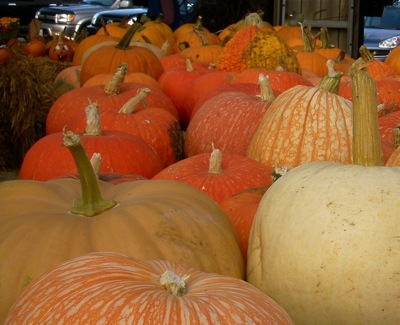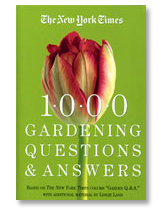Selecting Winter Squash (while there’s still something to select from)

To avoid the same old same old, stock up on winter squash while you can still buy it from a farmer.
(* Thanksgiving note: If you got here looking for pumpkin pie, rather than the other way ’round, there is now a detailed recipe.)
As a general rule, there’s no need to issue the annual squash warning until shortly before Thanksgiving. But tomatoes aren’t the only fruits that suffer when it’s cold and wet for weeks on end in June and July. This year has been very hard on a lot of squash growers in the Northeast and mid-Atlantic.
So I figure I ought to mention it now: If you want to eat good winter squash all winter and don’t want to die of boredom, this is the time to start cruising the farmstands looking for interesting squash and stocking up on an assortment, bearing in mind that “winter squash” is really 3 different vegetables – Cucurbita pepo, C. maxima and C. moschata – each with a different season of glory.
The Pepos ( pumpkin, Acorn, Delicata) are ready at harvest or shortly after, while Maximas ( Buttercup, hubbard, turban) are better after they’ve aged a while and Moschatas (mostly butternuts) don’t taste like much of anything until they’re a few months old.
There’s a longer list of examples near the end of Winter Squash, part 1, but given the hundreds of nifty squash out there it’s nice to know you can usually spot the species by looking at the stem.
Maxima has a round corky stem that sticks straight up.
Pepo has a 5 sided stem that flares at the base, then tapers gradually as it rises from the fruit.
Mochata has a narrow, ribbed stem that bulges into a big flare at the fruit end.
Like all vegetable rules, stem ID has plenty of exceptions and opportunities for confusion. But it does give you more than a start because the confusion is most often between pepo and moschata and most ( not all!) of the farmstand moschatas are immediately identifiable as butternuts. That’s a pepo in the mid left foreground, for instance, and the orange numbers in back of it are maximas until you get farther back, where the thing turns into pumpkin city, a different shade of orange.
More on the differences between species, a basic squash baking recipe that brings out best flavor and a few recipe suggestions are at Celebrating Squash, and if you’d like even more ways to treat squash as something more than a platform for butter and brown sugar, 18 of them can be found here.















Trackbacks/Pingbacks
Get a Trackback link